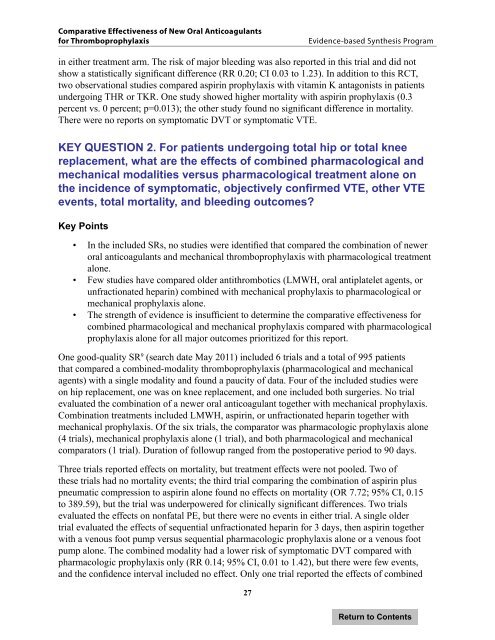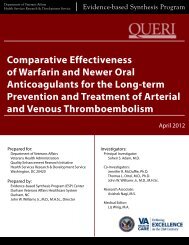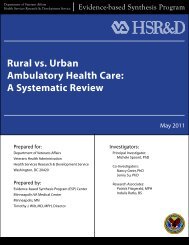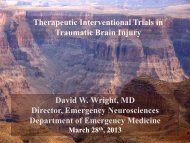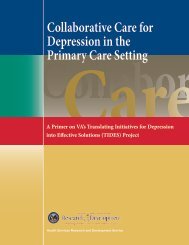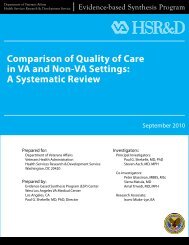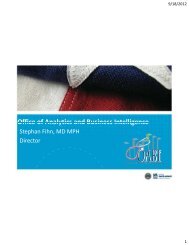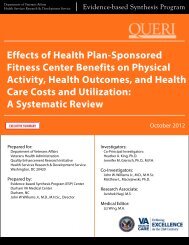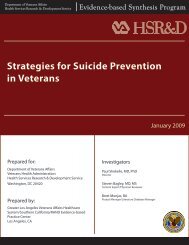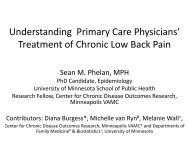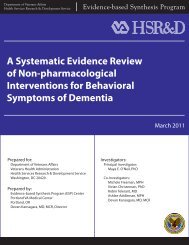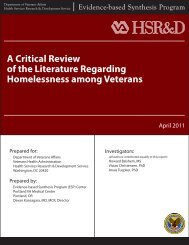Comparative Effectiveness of New Oral Anticoagulants for ...
Comparative Effectiveness of New Oral Anticoagulants for ...
Comparative Effectiveness of New Oral Anticoagulants for ...
You also want an ePaper? Increase the reach of your titles
YUMPU automatically turns print PDFs into web optimized ePapers that Google loves.
<strong>Comparative</strong> <strong>Effectiveness</strong> <strong>of</strong> <strong>New</strong> <strong>Oral</strong> <strong>Anticoagulants</strong><br />
<strong>for</strong> Thromboprophylaxis<br />
Evidence-based Synthesis Program<br />
in either treatment arm. The risk <strong>of</strong> major bleeding was also reported in this trial and did not<br />
show a statistically significant difference (RR 0.20; CI 0.03 to 1.23). In addition to this RCT,<br />
two observational studies compared aspirin prophylaxis with vitamin K antagonists in patients<br />
undergoing THR or TKR. One study showed higher mortality with aspirin prophylaxis (0.3<br />
percent vs. 0 percent; p=0.013); the other study found no significant difference in mortality.<br />
There were no reports on symptomatic DVT or symptomatic VTE.<br />
KEY QUESTION 2. For patients undergoing total hip or total knee<br />
replacement, what are the effects <strong>of</strong> combined pharmacological and<br />
mechanical modalities versus pharmacological treatment alone on<br />
the incidence <strong>of</strong> symptomatic, objectively confirmed VTE, other VTE<br />
events, total mortality, and bleeding outcomes?<br />
Key Points<br />
• In the included SRs, no studies were identified that compared the combination <strong>of</strong> newer<br />
oral anticoagulants and mechanical thromboprophylaxis with pharmacological treatment<br />
alone.<br />
• Few studies have compared older antithrombotics (LMWH, oral antiplatelet agents, or<br />
unfractionated heparin) combined with mechanical prophylaxis to pharmacological or<br />
mechanical prophylaxis alone.<br />
• The strength <strong>of</strong> evidence is insufficient to determine the comparative effectiveness <strong>for</strong><br />
combined pharmacological and mechanical prophylaxis compared with pharmacological<br />
prophylaxis alone <strong>for</strong> all major outcomes prioritized <strong>for</strong> this report.<br />
One good-quality SR 9 (search date May 2011) included 6 trials and a total <strong>of</strong> 995 patients<br />
that compared a combined-modality thromboprophylaxis (pharmacological and mechanical<br />
agents) with a single modality and found a paucity <strong>of</strong> data. Four <strong>of</strong> the included studies were<br />
on hip replacement, one was on knee replacement, and one included both surgeries. No trial<br />
evaluated the combination <strong>of</strong> a newer oral anticoagulant together with mechanical prophylaxis.<br />
Combination treatments included LMWH, aspirin, or unfractionated heparin together with<br />
mechanical prophylaxis. Of the six trials, the comparator was pharmacologic prophylaxis alone<br />
(4 trials), mechanical prophylaxis alone (1 trial), and both pharmacological and mechanical<br />
comparators (1 trial). Duration <strong>of</strong> followup ranged from the postoperative period to 90 days.<br />
Three trials reported effects on mortality, but treatment effects were not pooled. Two <strong>of</strong><br />
these trials had no mortality events; the third trial comparing the combination <strong>of</strong> aspirin plus<br />
pneumatic compression to aspirin alone found no effects on mortality (OR 7.72; 95% CI, 0.15<br />
to 389.59), but the trial was underpowered <strong>for</strong> clinically significant differences. Two trials<br />
evaluated the effects on nonfatal PE, but there were no events in either trial. A single older<br />
trial evaluated the effects <strong>of</strong> sequential unfractionated heparin <strong>for</strong> 3 days, then aspirin together<br />
with a venous foot pump versus sequential pharmacologic prophylaxis alone or a venous foot<br />
pump alone. The combined modality had a lower risk <strong>of</strong> symptomatic DVT compared with<br />
pharmacologic prophylaxis only (RR 0.14; 95% CI, 0.01 to 1.42), but there were few events,<br />
and the confidence interval included no effect. Only one trial reported the effects <strong>of</strong> combined<br />
27


